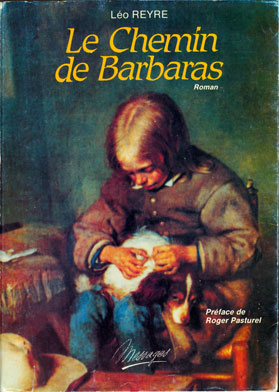 The Chemin de Barbaras was a trading route between Avignon and Barbaras during the middle ages. The novel by Léo Reyre contains a preface written by Roger Pasturel which relates some interesting historical facts. Here are some excerpts:
The Chemin de Barbaras was a trading route between Avignon and Barbaras during the middle ages. The novel by Léo Reyre contains a preface written by Roger Pasturel which relates some interesting historical facts. Here are some excerpts:"... It was by pure accident that a fairly recent map of the states of Provence was placed before my eyes, lifting a corner of the veil: somewhere between Bouchet and Tulette, printed in letters of equal size, was the domaine of Barbaras, represented by a clock and one or two houses which, today, have been completely erased from the land.
Here then is the raison d'être of this famous route.
Subsequently, the local scholars taught me that the barbarians' quarter, north-west of Visan, no dought perpetuated the memory, proving at the same meeting that time has less hold over words than over stones.
... The enclave, papal territory, was to Avignon as Avignon was to Rome. All around was, quite simply, the kingdom of France, the foreign land. And the Barbaras road, cleverly sold by the pontiff to the count of Suze, was the sole route that was usable by the subjects of his Holiness the Pope for traveling from their land to Avignon and back through French territory.
In France there was an onerous salt tax which was to salt as is today's Régie, the state-controlled tobacco and cigarette company.
Salt and many other commodities were circulated more freely in the pontifical states and done so at prices that one would be considered very attractive today.
Result: Valréas was a smuggler's den, the Barbaras road was the salt route and, in each grove, the tax collectors of the king of France lay in wait, ready to pounce on the first pontifical donkey carrying salt which, covered by some royal thistle, would have been caught red-handed in violation of French territory.
... Thus, throughout the Comtat Venaissin, one wondered whether to declare oneself for France or for the Vatican. Overwelmingly, our Valréassian ancestors voted for the Pope... and the salt. But the rest of the Comtat, lead by the Avignonians, threw the Comtat into the arms of the young French republic.
It was necessary to become aligned - against one's heart, it must be said -.
Hello, the list of grievances, the fruits of liberty, the people's banquets, counter-revolution and the guillotine.
Farewell tax collectors, farewell to the Barbaras road."
Here then is the raison d'être of this famous route.
Subsequently, the local scholars taught me that the barbarians' quarter, north-west of Visan, no dought perpetuated the memory, proving at the same meeting that time has less hold over words than over stones.
... The enclave, papal territory, was to Avignon as Avignon was to Rome. All around was, quite simply, the kingdom of France, the foreign land. And the Barbaras road, cleverly sold by the pontiff to the count of Suze, was the sole route that was usable by the subjects of his Holiness the Pope for traveling from their land to Avignon and back through French territory.
In France there was an onerous salt tax which was to salt as is today's Régie, the state-controlled tobacco and cigarette company.
Salt and many other commodities were circulated more freely in the pontifical states and done so at prices that one would be considered very attractive today.
Result: Valréas was a smuggler's den, the Barbaras road was the salt route and, in each grove, the tax collectors of the king of France lay in wait, ready to pounce on the first pontifical donkey carrying salt which, covered by some royal thistle, would have been caught red-handed in violation of French territory.
... Thus, throughout the Comtat Venaissin, one wondered whether to declare oneself for France or for the Vatican. Overwelmingly, our Valréassian ancestors voted for the Pope... and the salt. But the rest of the Comtat, lead by the Avignonians, threw the Comtat into the arms of the young French republic.
It was necessary to become aligned - against one's heart, it must be said -.
Hello, the list of grievances, the fruits of liberty, the people's banquets, counter-revolution and the guillotine.
Farewell tax collectors, farewell to the Barbaras road."

